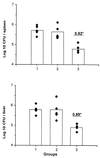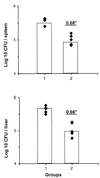gp96-peptide vaccination of mice against intracellular bacteria
- PMID: 11349093
- PMCID: PMC98486
- DOI: 10.1128/IAI.69.6.4164-4167.2001
gp96-peptide vaccination of mice against intracellular bacteria
Abstract
This work demonstrates that gp96 preparations isolated from cells infected with intracellular bacteria induce cytotoxic T-lymphocyte responses and confer protection. Our findings extend previous reports on the immunogenicity of gp96-associated peptides to antigens derived from intracellular bacteria. Immunization with gp96 may therefore represent a promising vaccination strategy against bacterial pathogens.
Figures



Similar articles
-
Administration of superantigens protects mice from lethal Listeria monocytogenes infection by enhancing cytotoxic T cells.Infect Immun. 2001 Nov;69(11):6633-42. doi: 10.1128/IAI.69.11.6633-6642.2001. Infect Immun. 2001. PMID: 11598032 Free PMC article.
-
Enhanced protection against tuberculosis by vaccination with recombinant Mycobacterium microti vaccine that induces T cell immunity against region of difference 1 antigens.J Infect Dis. 2004 Jul 1;190(1):115-22. doi: 10.1086/421468. Epub 2004 Jun 4. J Infect Dis. 2004. PMID: 15195250
-
[Novel vaccines against M. tuberculosis].Kekkaku. 2006 Dec;81(12):745-51. Kekkaku. 2006. PMID: 17240920 Review. Japanese.
-
Therapeutic efficacy of a tuberculosis DNA vaccine encoding heat shock protein 65 of Mycobacterium tuberculosis and the human interleukin 2 fusion gene.Tuberculosis (Edinb). 2009 Jan;89(1):54-61. doi: 10.1016/j.tube.2008.09.005. Epub 2008 Dec 3. Tuberculosis (Edinb). 2009. PMID: 19056317
-
Unique functions of splenic CD8alpha+ dendritic cells during infection with intracellular pathogens.Immunol Lett. 2007 Dec 15;114(2):66-72. doi: 10.1016/j.imlet.2007.09.007. Epub 2007 Oct 12. Immunol Lett. 2007. PMID: 17964665 Review.
Cited by
-
Increased proteolysis of diphtheria toxin by human monocytes after heat shock: a subsidiary role for heat-shock protein 70 in antigen processing.Immunology. 2007 Feb;120(2):230-41. doi: 10.1111/j.1365-2567.2006.02494.x. Epub 2006 Nov 20. Immunology. 2007. PMID: 17116171 Free PMC article.
-
Essential role of CD91 in re-presentation of gp96-chaperoned peptides.Proc Natl Acad Sci U S A. 2004 Apr 20;101(16):6128-33. doi: 10.1073/pnas.0308180101. Epub 2004 Apr 8. Proc Natl Acad Sci U S A. 2004. PMID: 15073331 Free PMC article.
-
Establishment of tumor-associated immunity requires interaction of heat shock proteins with CD91.Cancer Immunol Res. 2014 Mar;2(3):217-28. doi: 10.1158/2326-6066.CIR-13-0132. Epub 2013 Dec 31. Cancer Immunol Res. 2014. PMID: 24778318 Free PMC article.
-
DNA immunization as an efficient strategy for vaccination.Avicenna J Med Biotechnol. 2009 Jul;1(2):71-88. Avicenna J Med Biotechnol. 2009. PMID: 23407787 Free PMC article.
-
Gp96 rich lysate as a vaccine candidate against infection with Salmonella typhimurium.Iran J Microbiol. 2010 Dec;2(4):172-7. Iran J Microbiol. 2010. PMID: 22347568 Free PMC article.
References
-
- Arnold-Schild D, Hanau D, Spehner D, Schmid C, Rammensee H G, de la Salle H, Schild H. Receptor-mediated endocytosis of heat shock proteins by professional antigen-presenting cells. J Immunol. 1999;162:3757–3760. - PubMed
-
- Binder R J, Han D K, Srivastava P K. CD91: a receptor for heat shock protein gp96. Nat Immunol. 2000;1:151–153. - PubMed
MeSH terms
Substances
LinkOut - more resources
Full Text Sources
Other Literature Sources
Medical

